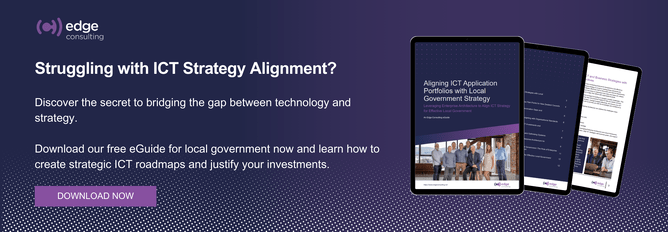A strategic guide for ICT leaders to manage risks and drive decision-making
For ICT leaders in local government organisations, achieving visibility in application portfolios is crucial for operational efficiency and effective service delivery. Budgetary constraints, risk management issues, and a lack of visibility across application portfolios can create barriers to effective decision-making. When ICT teams lack detailed insights—such as understanding when applications require renewals or ensuring they meet security standards—they struggle to manage risks effectively and plan for the future.
Jason Fazackerley, our principal consultant for enterprise architecture, explains why he believes this is where Enterprise Architecture (EA) plays a crucial role. By providing a structured framework for standardising and aligning technology with the broader goals of public services, EA empowers local government ICT leaders to enhance visibility in their application portfolios. This alignment ensures that technology investments meet operational needs and public expectations. Importantly, it helps to align ICT initiatives with business strategy, boosting overall organisational efficiency and effectiveness.
How can local governments achieve this? By leveraging Edge Consulting’s practical implementation of Enterprise Architecture alongside supporting Solutions Architecture services, organisations can conduct current state analyses, future state planning, change modelling, and gather informative data across the business and digital landscape. A strategic approach which ensures resources invested in ICT initiatives directly benefit the organisation's core business services.
Understanding application portfolios in local government
An application portfolio is a fundamental component of every organisation's ICT infrastructure. It represents a structured repository of software assets, ideally related to business services, business capabilities, and other organisational elements. Despite its significance, many NZ local government ICT teams struggle to effectively manage and maintain their application portfolios.
When ICT leaders have comprehensive visibility over their application portfolio, it acts as a consolidated inventory of their software assets. By centralising this information, ICT leaders can easily reference, and access critical business relevant attributes and metadata related to their applications, facilitating informed decision-making and strategic planning. Most importantly, it allows ICT to align their efforts with organisational goals, addressing both immediate and future technology needs.
Improving application portfolio management with related application attributes
An ICT application portfolio is a valuable asset, but its true potential is unlocked through the addition of related application attributes or metadata. Metadata enhances visibility by adding a rich, data-driven narrative to the portfolio, offering deeper insights into applications within their organisational context. This enhanced understanding allows for more effective analysis of key business factors such as:
Total Cost of Ownership (TCO)
Risk
Recoverability
Cloud readiness
Platform
Complexity
Criticality
Business owner
Subject matter expert
Although we have suggestions for these attributes, they are defined by the needs and requirements of the organisation. Leveraging metadata provides much-needed clarity in areas like security, application lifecycle, and business alignment, ultimately supporting more strategic decision-making.
By incorporating metadata into application portfolio management, local government organisations gain a clearer view of their ICT assets. This comprehensive insight supports informed decision-making, improves system performance, and optimises resource management.
Leveraging enterprise architecture to align application portfolios
The power of metadata becomes even more significant when aligned and viewed with organisational goals. This combined approach enables ICT teams to assess not only the current state of their applications but also their alignment with enterprise-wide standards, public service objectives and other established strategic goals.
Because of the complexity of ICT systems through applications, infrastructure and data, Business leaders may not fully appreciate the potential impacts of ICT decisions on overall operations, leading to misaligned priorities.
By standardising application metrics through EA, local governments can ensure that technology investments are made strategically. EA allows ICT leaders to map out critical business services supported by their applications, identify overlaps or gaps, align criticality and availability across those services, and plan for future growth or changes. The added layer of metadata brings a level of detail that supports decision-making at every level, ensuring that technology serves the broader goals of efficiency, compliance, and resilience.
With EA and metadata working in tandem, local government ICT teams can transform their application portfolios into assets that drive both operational success and public value.
Improving application portfolio visibility for effective decision-making in local government
Achieving visibility and effective management of application portfolios is critical for local government organisations striving for operational excellence and cost efficiencies. By leveraging Enterprise Architecture and aligning ICT procurement processes with EA standards, and the insights derived from the Application portfolio and its metadata, local governments can enhance their decision-making capabilities and drive efficiency across their operations. Clear communication between ICT and business departments is essential ensuring that all technology investments align with broader organisational goals. This proactive approach not only addresses potential challenges but also empowers local governments to navigate the complexities of their application landscapes effectively.
To explore these strategies in more depth and enhance your organisation's approach to application portfolio visibility, download our eGuide on Aligning ICT Application Portfolios with Local Government Strategy.

